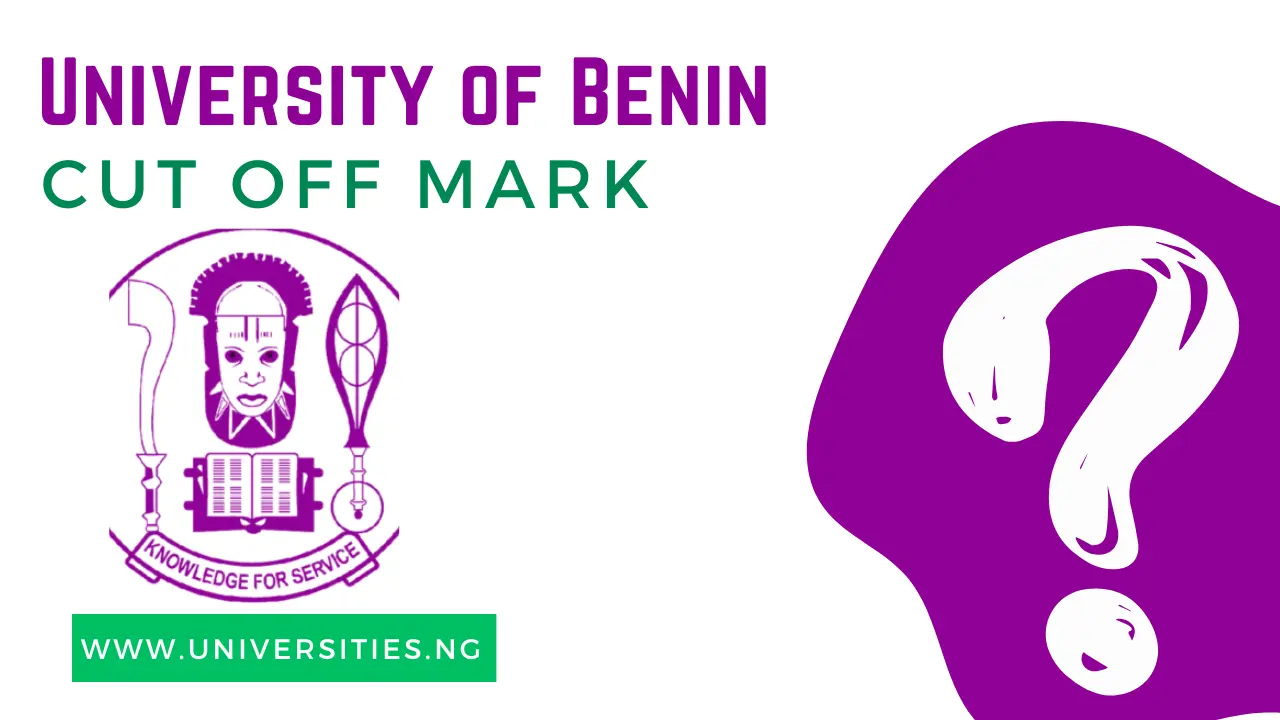The University of Benin (UNIBEN) is one of Nigeria’s top universities. Every year, thousands of students apply, hoping to gain admission. However, not all applicants get in. One key factor that determines admission is the cut off mark. This article explains what a cut off mark is, UNIBEN’s cut off mark for the 2024/2025 academic session, how it is determined, and what to do if you don’t meet the requirement.
What Is a Cut Off Mark?
A cut off mark is the minimum score a candidate must get in an exam to qualify for admission. Universities, polytechnics, and colleges set their own cut off marks based on their admission criteria. For UNIBEN, the cut off mark is set based on the Joint Admissions and Matriculation Board (JAMB) guidelines and other internal factors.
There are two types of cut off marks:
- JAMB Cut Off Mark – This is the minimum score required by JAMB for any candidate to apply for a university.
- Departmental Cut Off Mark – This is the specific score required for different courses at UNIBEN. Some courses have higher cut off marks due to high competition.
UNIBEN Cut Off Mark for all courses
For the 2024/2025 session, UNIBEN’s general JAMB cut off mark is 200. This means that any candidate who scores below 200 in JAMB cannot apply for admission into UNIBEN. However, some competitive courses have higher cut off marks, which vary by department.
Here’s a breakdown of cut off marks for some major faculties:
Course | Cut-Off Mark |
|---|---|
Faculty of Agriculture | |
Agricultural Economics | 200 |
Animal Science | 200 |
Crop Science | 200 |
Fisheries | 200 |
Forestry and Wildlife | 200 |
Soil Science | 200 |
Faculty of Arts | |
English and Literature | 210 |
Fine and Applied Arts | 200 |
Foreign Languages | 200 |
History | 200 |
Linguistics | 200 |
Mass Communication | 220 |
Philosophy | 200 |
Religious Studies | 200 |
Theatre Arts | 200 |
Faculty of Basic Medical Sciences | |
Anatomy | 220 |
Medical Biochemistry | 220 |
Nursing Science | 220 |
Physiology | 220 |
Physiotherapy | 220 |
Radiography and Radiation Science | 220 |
Faculty of Dentistry | |
Dental Surgery | 220 |
Faculty of Education | |
Adult Education | 200 |
Agricultural Education | 200 |
Business Education | 200 |
Computer Education | 200 |
Educational Management | 200 |
English Education | 200 |
Fine and Applied Arts Education | 200 |
French Education | 200 |
Geography Education | 200 |
Health Education | 200 |
History Education | 200 |
Human Kinetics | 200 |
Library and Information Science | 200 |
Mathematics Education | 200 |
Political Science Education | 200 |
Religious Studies Education | 200 |
Science Education | 200 |
Social Studies Education | 200 |
Faculty of Engineering | |
Chemical Engineering | 220 |
Civil Engineering | 220 |
Computer Engineering | 220 |
Electrical/Electronic Engineering | 220 |
Mechanical Engineering | 220 |
Petroleum Engineering | 220 |
Production Engineering | 220 |
Structural Engineering | 220 |
Faculty of Environmental Sciences | |
Architecture | 200 |
Estate Management | 200 |
Quantity Surveying | 200 |
Surveying and Geoinformatics | 200 |
Faculty of Law | |
Law | 220 |
Faculty of Life Sciences | |
Biochemistry | 200 |
Environmental Management and Toxicology | 200 |
Microbiology | 200 |
Plant Biology and Biotechnology | 200 |
Animal and Environmental Biology | 200 |
Faculty of Management Sciences | |
Accounting | 220 |
Banking and Finance | 220 |
Business Administration | 220 |
Entrepreneurship | 200 |
Insurance | 200 |
Marketing | 200 |
Faculty of Pharmacy | |
Pharmacy | 220 |
Faculty of Physical Sciences | |
Chemistry | 200 |
Computer Science | 200 |
Geology | 200 |
Industrial Chemistry | 200 |
Industrial Mathematics | 200 |
Industrial Physics | 200 |
Mathematics | 200 |
Physics | 200 |
Statistics | 200 |
Faculty of Social Sciences | |
Economics and Statistics | 200 |
Geography and Regional Planning | 200 |
Political Science and Public Administration | 200 |
Sociology and Anthropology | 200 |
Social Work | 200 |
Faculty of Veterinary Medicine | |
Veterinary Medicine | 200 |
These are estimates. UNIBEN may adjust the cut off marks based on the number of applicants and their performance in JAMB and Post-UTME.
How Is UNIBEN Cut Off Mark Determined?
Several factors influence UNIBEN’s cut off mark each year:
- Number of Applicants – If more people apply for a course, the cut off mark will likely be higher.
- General Performance in JAMB – If most applicants score high, the university may raise the cut off mark.
- Course Demand – Courses like Medicine, Law, and Engineering often have higher cut off marks because they attract many students.
- Quota System – UNIBEN follows a quota system to ensure fair admission across states and departments.
Post-UTME Screening and Aggregate Score Calculation
Scoring above the JAMB cut off mark does not guarantee admission into UNIBEN. Candidates must also pass the Post-UTME screening. UNIBEN uses a 50:50 system, where JAMB and Post-UTME scores are weighted equally.
Here’s how to calculate your aggregate score:
- Divide your JAMB score by 8.
- Divide your Post-UTME score by 2.
- Add both results together.
Example: If a student scores 280 in JAMB and 70 in Post-UTME:
- JAMB: 280/8 = 35
- Post-UTME: 70/2 = 35
- Aggregate Score: 35 + 35 = 70
The departmental cut off mark will then determine whether you qualify for your chosen course.
What to Do If You Don’t Meet the Cut Off Mark
If you don’t meet UNIBEN’s cut off mark, you still have options:
- Change of Course – Apply for a less competitive course with a lower cut off mark.
- Change of Institution – Consider applying to another university with a lower cut off mark.
- Pre-degree or JUPEB Program – UNIBEN offers a JUPEB program that allows students to gain admission directly into 200 level after one year.
- Try Again Next Year – You can retake JAMB and aim for a higher score.
Final Recommendations
- Score as High as Possible – The higher your JAMB and Post-UTME scores, the better your chances.
- Prepare Well for Post-UTME – Since Post-UTME contributes 50% to your admission chances, study hard.
- Have a Backup Plan – Consider other universities, courses, or pre-degree programs if needed.
- Stay Updated – Follow UNIBEN’s official website for the latest admission news.
Conclusion
UNIBEN’s cut off mark plays a big role in the admission process. While the general cut off mark is 200, different courses have their own requirements. High-demand courses require higher scores, so students must aim high. If you don’t meet the cut off mark, there are alternatives. Stay informed, prepare well, and increase your chances of getting into UNIBEN.








